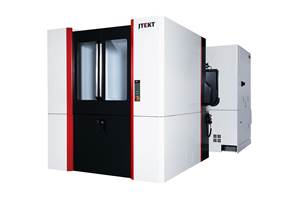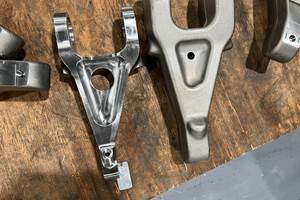New Fixture Multiplies Productivity Of Horizontal Machining Center
The setup for batch processing of each stem version and time expended in load/unload for the second operation created a production bottleneck that became more critical as market demand for the part took off.
Share





L.H. Thomson Company (Macon, Georgia) is an aircraft sub-contractor and maker of after-market components for high performance mountain and road bikes. One particular bike component is a line of aluminum handlebar stems. Sixty-four versions of the stem are made, combining different lengths, rise angles ranging from –10 and +15 degrees and two different handlebar diameters. All versions require machining on all six sides. Each end of the stem has features that must be parallel with or perpendicular to its centerline. Traditional processing of the component required two operations. The setup for batch processing of each stem version and time expended in load/unload for the second operation created a production bottleneck that became more critical as market demand for the part took off.
Company president Ronnie Thomson and vice president Randy Tolbert attended a major machine tool show to search for a solution to their bottleneck. No commercially available package they could find could combine their operations into a single setup.
After their fruitless search, Mr. Thomson and Mr. Tolbert conceived of a new fixturing approach that can eliminate work handlings for second operations. It lets a standard A-55E horizontal machining center from Makino (Mason, Ohio) tackle five-sided machining on eight work parts in a single setup.
Development of the fixture details was the work of L. H. Thomson design and process engineers. Mr. Thomson ultimately called on sales engineer George "Bud" Cowan of Beckman Precision Inc. (Greer, South Carolina) to help integrate the new fixture into a horizontal machining center system. Mr. Cowan coordinated the efforts of the Beckman Precision applications support team, a custom hydraulic systems supplier and Makino with the A-55E horizontal machining center.
The company's patent-pending fixture is based on a high precision, four-sided tombstone design. It is mounted on the A-55E's standard rotary contouring table. Each side of the tombstone incorporates a rotary indexing fixture that holds two work parts. This arrangement provides full CNC contouring when rotating around the vertical axis and hydraulically actuated indexing around each horizontal axis. With these combined motions, all sides of each workpiece are accessed in one operation, even the sixth side (the back of the work part) for true "done in one" machining.
The A-55E control provides master program and sub-program functionality that lets one program address all 64 stem versions. The operator enters three parameters to program the machine for each specific stem.
Repeatability of the fixture is within 0.0001 inch at 8 inches from the indexing fixture's centerline. The hydraulic system that produces fast fixture indexing also provides a positive in-position verification using a pneumatic sensing circuit. Integrated design places all the actuation hardware inside the 10-inch by 10-inch tombstone, with power supplied through a rotary coupling mounted at the top. Open access for loading the fixtures is from the front of the machine. An after-market light curtain disables automatic functions during load/unload. Dual palm buttons provide the safety interlock to enable fixture motions.
Machining operations include drilling of blind holes as large as 1.113 inches in diameter and up to 2 inches deep. Integral shank drills from Kennametal turn at 14,000 rpm and feed at 168 ipm, finishing the deepest holes in under 0.7 second. To keep chips clear and temperatures low, the A-55E is equipped with an optional 1,000 psi coolant system. Deburring of the complex cross-holes, threaded sections and exterior is performed in the fixture using a carbide ball deburring tool in the A-55E spindle.
High speed milling on the stems uses a ¾-inch end mill at 14,000 rpm. It feeds at 400 ipm, cuts at 2,748 sfpm and is completely buried when cutting around the ends of the stem, actually cutting off a complete piece of stock, not making chips, and creating a finish that requires no polishing.
Related Content
JTEKT Launches New Series of HMCs
The new FH5000 series machines include a 500-mm table capable of handling 1,000-kg loads.
Read MoreWeingärtner Maschinenbau HMC Provides Stable Machining
The MPMC features a wide base, optimized guide ratio and configuration of the guideways to provide stability and prevent vibration during operation, even under extreme cutting conditions.
Read MoreHorizontal High-Speed Machining Saves Hundreds of Work Hours
High-speed machining is the latest change at Blair-HSM South, helping this once old-fashioned shop improve productivity and morale while enabling new work.
Read MoreDN Solutions America Unveils Impressive Chicago Technical Center at IMTS 2024
New tech center is serving as a cutting-edge showroom and a technological hub for advanced machining applications.
Read MoreRead Next
Setting Up the Building Blocks for a Digital Factory
Woodward Inc. spent over a year developing an API to connect machines to its digital factory. Caron Engineering’s MiConnect has cut most of this process while also granting the shop greater access to machine information.
Read More5 Rules of Thumb for Buying CNC Machine Tools
Use these tips to carefully plan your machine tool purchases and to avoid regretting your decision later.
Read MoreRegistration Now Open for the Precision Machining Technology Show (PMTS) 2025
The precision machining industry’s premier event returns to Cleveland, OH, April 1-3.
Read More





















.jpg;maxWidth=300;quality=90)











